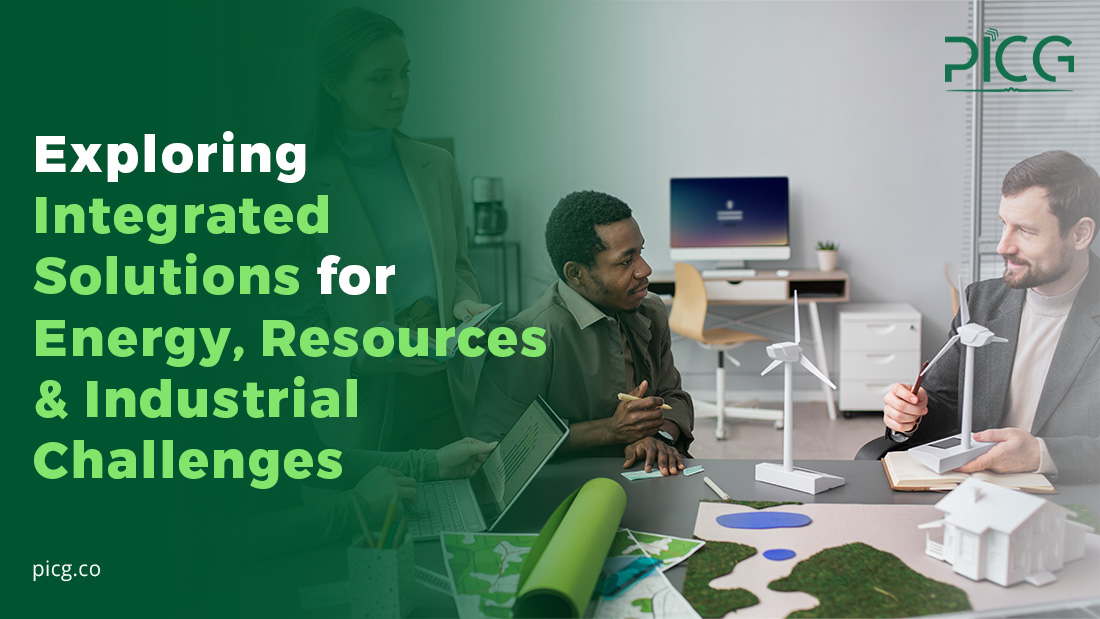


PICG

Our world faces a complex challenge: ensuring we have enough energy to power our lives, resources to sustain us, and industries that function efficiently, all while protecting the environment. This may seem like a three-headed monster, but the good news is, there's a growing movement towards **integrated solutions**.
Factories use renewable energy sources like solar and wind
Waste from one industry becomes fuel for another
Smart grids manage energy flow efficiently, reducing waste
That's the power of integrated solutions – creating a more sustainable and interconnected system for our energy, resources, and industries.
Let's break down the challenges we face in each area:
Energy: Our reliance on fossil fuels contributes to climate change. We need cleaner and more sustainable energy sources.
Resources: Fresh water, minerals, and other resources are under increasing pressure. We need to use them more efficiently and find alternatives.
Industry: Traditional industrial processes can be wasteful and pollute the environment. We need to find ways to make them cleaner and more efficient.
By using renewable energy sources, we can reduce our dependence on fossil fuels and combat climate change.
By developing a circular economy, where waste from one industry becomes a resource for another, we can conserve resources and reduce pollution.
By adopting smart technologies and innovative processes, industries can operate more efficiently and cleanly.
Here are some exciting examples of how integration is making a difference:
Industrial Symbiosis: Imagine a paper mill that uses leftover wood heat from a nearby power plant to dry its paper. This reduces the mill's energy consumption and saves the power plant from wasting excess heat. It's a win-win!
Smart Grids: These intelligent power grids can manage energy flow based on real-time demand. They can integrate renewable energy sources more effectively and reduce energy waste. Think of it like a smart traffic system for electricity!
Waste-to-Energy: Technologies are being developed to convert waste products like municipal solid waste into electricity or fuel. This reduces landfill dependence and creates a new source of energy.
There are many advantages to pursuing integrated solutions:
Environmental Sustainability: By using cleaner energy sources, reducing waste, and improving industrial efficiency, we can significantly reduce our environmental impact.
Resource Conservation: By utilizing resources more efficiently and finding alternatives, we can ensure they last for future generations.
Economic Growth: Innovation and new technologies create new jobs and business opportunities in the clean energy sector and resource management.
Energy Security: By diversifying our energy sources and improving grid resilience, we become less dependent on traditional energy sources and external factors.
Of course, there are challenges to overcome:
Initial Investment: Developing and implementing integrated solutions can require upfront investment in new technologies and infrastructure.
Policy and Regulation: Supportive government policies and regulations are needed to incentivize investment in integrated solutions and create a level playing field for new technologies.
Collaboration: Integration requires collaboration between different industries, government agencies, and research institutions.
While large-scale changes require collective efforts, there are things we can all do as individuals to support integrated solutions:
Support Businesses Committed to Sustainability: Choose products and services from companies that prioritize clean energy and resource efficiency.
Reduce Your Energy Consumption: Simple steps like turning off lights in unused rooms and using energy-efficient appliances can make a difference.
Stay Informed and Advocate for Change: Learn more about integrated solutions and support policies that promote sustainability.
Integrated solutions offer a promising path towards a more sustainable future. By working together, we can build a world where our energy needs are met cleanly, our resources are used responsibly, and our industries thrive in harmony with the environment. Let's bridge the gaps and create a future that benefits everyone!